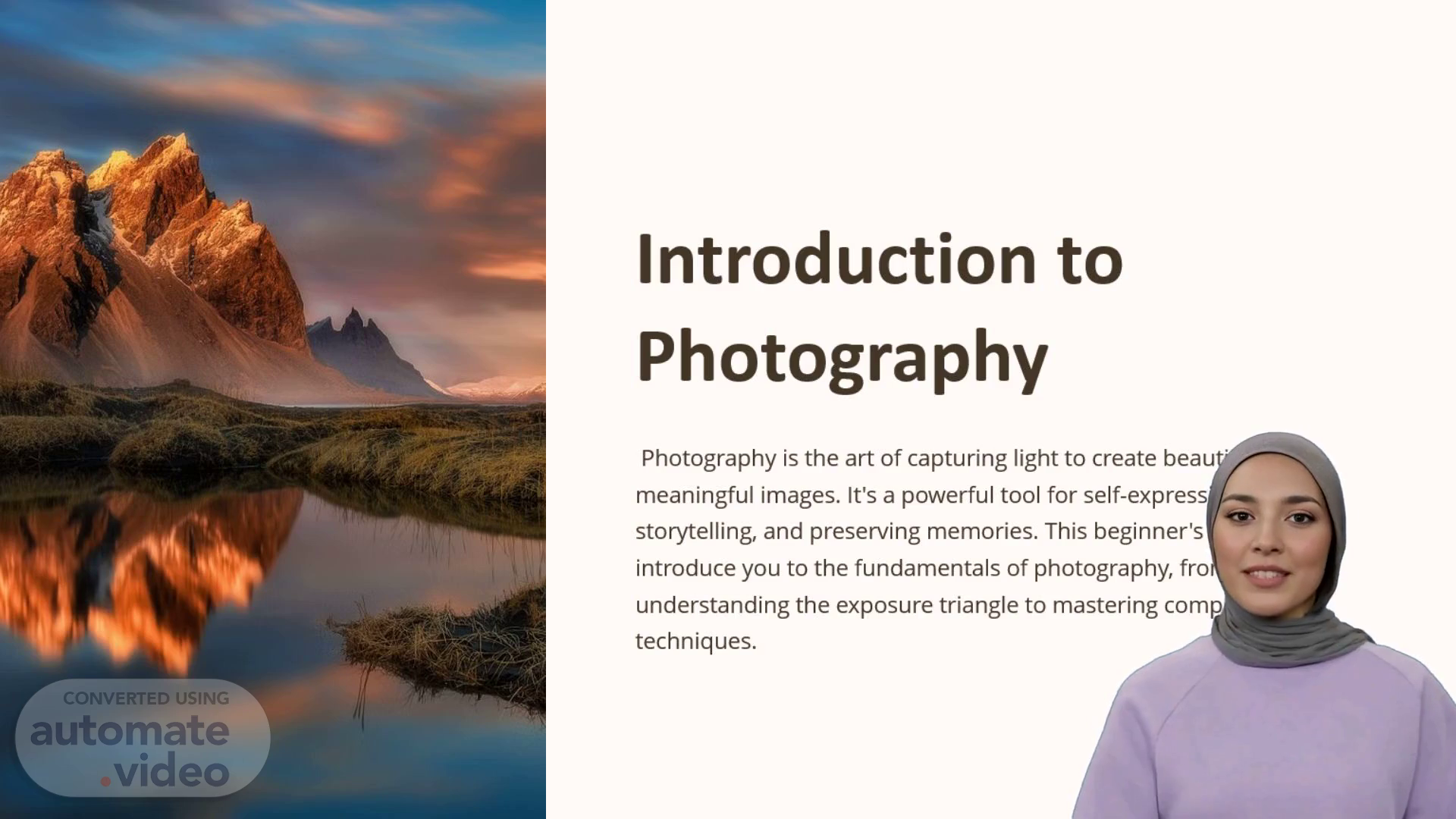
PptxGenJS Presentation
Scene 1 (0s)
[Virtual Presenter] We explore the world of photography.
Scene 2 (4s)
[Audio] We believe that understanding the fundamental concepts of photography is crucial. Mastering aperture shutter speed and I-S-O can create beautiful and meaningful images..
Scene 3 (17s)
[Audio] Aperture is a fundamental concept in photography that refers to the opening in the lens through which light enters. It's measured in f-stops with a lower number indicating a wider aperture and a higher number indicating a narrower aperture. A wider aperture (lower f-number) creates a shallow depth of field which means that only a small portion of the image will be in focus while the rest will be blurred. This effect is often used for portraits or macro photography to create a bokeh effect. A narrower aperture (higher f-number) creates a deeper depth of field which means that more of the image will be in focus. This effect is often used for landscape photography to capture more detail in the background. By understanding aperture and depth of field you can create more meaningful and expressive images..
Scene 4 (1m 9s)
[Audio] We will discuss the importance of mastering shutter speed in photography specifically its role in capturing motion. Shutter speed controls the length of time the camera's sensor is exposed to light. By adjusting it you can control the amount of motion in your images. Fast shutter speeds can freeze action while slow shutter speeds can create a sense of motion. Pan for effect is an effective technique to achieve this. Experimenting with different shutter speeds can help you create your perfect motion-filled images..
Scene 5 (1m 41s)
[Audio] Low light photography is an important aspect of photography that allows you to capture images in low light conditions such as indoors or at night. When shooting in low light it is important to adjust the I-S-O setting to capture the best possible image. By increasing the I-S-O you can achieve faster shutter speeds and smaller apertures which can help to reduce motion blur and increase the depth of field. However it's important to keep in mind that increasing the I-S-O can also introduce noise and grain into the image. This is where shooting in R-A-W format comes in. By shooting in R-A-W you have more flexibility in post-processing to reduce noise and improve image quality. In addition to adjusting I-S-O and shooting in R-A-W it's important to also pay attention to lighting techniques. By using the right lighting techniques you can create images that are both visually appealing and technically sound. Overall low light photography can be a challenge but with the right techniques and tools you can create stunning images that capture the beauty of light in any situation..
Scene 6 (2m 51s)
[Audio] We will discuss the importance of composition techniques in creating visually appealing and balanced photographs. The rule of thirds is a widely used technique that involves dividing the frame into nine equal parts and placing important elements at the intersections or along the lines to create a more balanced and visually appealing composition. Leading lines which use lines paths or shapes to guide the viewer's eye through the frame and towards the main subject also add depth and create a sense of movement. Framing using elements such as doorways windows or branches to create a natural frame around the subject adds depth and draws attention to the main focus. Negative space utilizing the empty areas of the frame to create a sense of balance and simplicity also enhances the subject's visual appeal. By understanding and applying these composition techniques photographers can create more visually appealing and balanced photographs that effectively communicate their intended message..
Scene 7 (3m 53s)
[Audio] We have two options for framing in photography: eye level and shooting at eye level. Eye level framing creates a natural and straightforward perspective that the viewer can easily relate to. On the other hand shooting from a higher perspective can make the subject appear smaller and more vulnerable conveying a sense of power or dominance. Moreover we can also use low angle perspective where we can shoot from a lower perspective which can make the subject appear larger and more powerful. Mastering these different framing techniques can add depth and dimension to your photographs making them more interesting and engaging to view..
Scene 8 (4m 30s)
[Audio] Practice practice practice is the key to improving your photography skills. Take as many pictures as possible experiment with different techniques and settings. Find your style and let your creativity shine through..